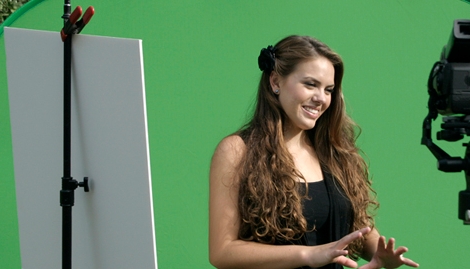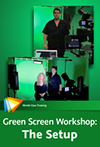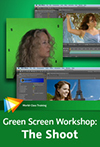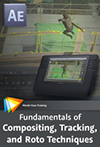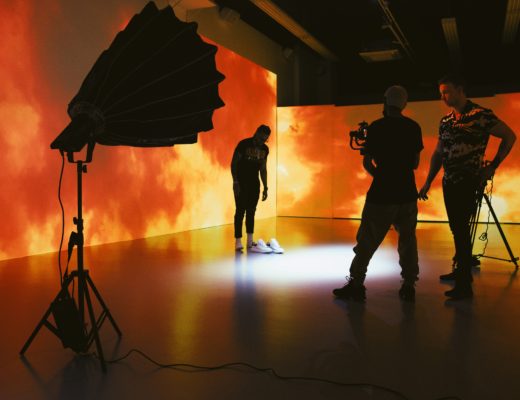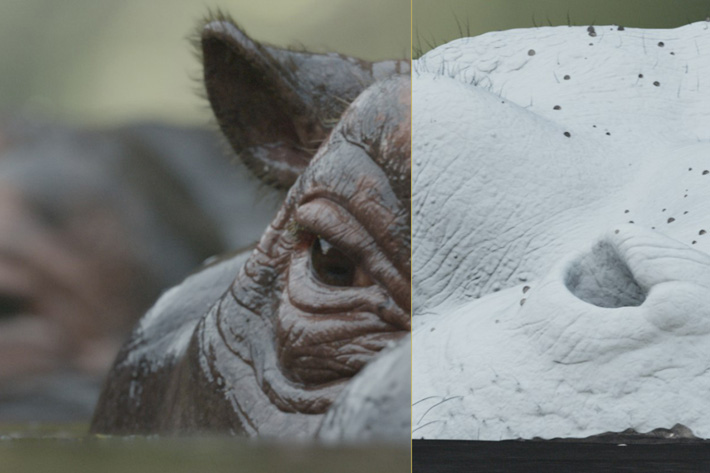![]()
Okay, you’ve seen the green screen “Kits” that come with some cheap lights, stands and a green screen cloth backdrop… or someone tells you to just go down to Home Depot and get a couple gallons of their “greenest” paint – a couple hundred bucks and you’re good to go, right? WRONG! A setup like that will be of little use if you’re seriously trying to get a decent matte. Without the right green screen materials, even the best lighting and camera won’t help you.
The entire green screen process is a careful balance of color & light – a very narrow spectrum of colored light that reflects back through the lens and is easily matted (or “keyed”) out with sophisticated software.
Here’s a video run-down of several material comparisons, from my training title Green Screen Workshop: The Setup![]()
The following is excerpted from my book The Green Screen Handbook (Sybex/Wiley, pub ISBN#0470521074) available on Amazon.com
– – –
Green Screen and Blue Screen Materials
You can use many materials for green screen and blue screen compositing, depending on your location, the scale of the project, the method of keying you’ll use, and, of course, your budget. Large-scale projects such as motion-picture production use huge sets with seamless painted walls, cycs, and floors-not to mention a vast array of lights. On the opposite end of the spectrum, a low-budget independent video project or interview may use a pop-up green screen or even a piece of green material suspended from a rod or frame, with a couple portable lights. In either case, knowing what you need to accomplish and doing some prior planning will help you get the most out of the materials you have at your disposal.
Painted Walls, Cycs, and Floors
In most cases, smaller studios have a flat wall that’s painted evenly with green screen paint. A painted wall is easier to light evenly than a stretched or hanging fabric background, because it’s flat, smooth, and has an even texture. The best paints to use are either Rosco’s Chroma Key paints and DigiComp paints or Composite Components’ Digital Green, Digital Blue, or other colors. These paints are manufactured specifically for the correct color density and finish to give the proper amount of light reflectivity, saturation, and evenness on your painted surfaces. If you do some comparison shopping, you’ll find that not just any green paint will work, and trying to get something mixed at your hardware store will probably give you more headaches than positive results. This isn’t to say that you can’t make it work. Many people have done low-budget shoots and had decent results from hardware store green and blue paint. If you’re on a tight budget and that’s all you can get your hands on, then using some green Kino Flo bulbs can help make up for it; but you’ll probably spend much more time cleaning up poor-quality composite shots than if you use a paint made specifically for digital matte keying.
Note that painting your walls will require you to repaint periodically to cover up scuffs, smears, and handprints. Digital matte paint doesn’t touch up well, and it’s recommended that you repaint the entire surface as needed. With the premium digital matte paints costing upward of $60 per gallon, it’s advisable that you try to keep your walls clean and free from contact as much as possible.
When you need a larger area, it’s not always necessary to have a huge studio to achieve a near-infinite wall if you can build or install a cyc wall system. A cyc (short for cyclorama) is a seamless curved surface that joins the wall to the floor in a smooth transition. Infinity cycs are also curved to the adjoining right-angled wall, creating curved corners with an intricate three-directional corner joint. A few people have successfully built their own permanent cyc walls with building
materials, plaster, and paint, which works if you’re on a budget and are handy with construction. However, kit products offer flexibility, easy of installation, and, in some cases, portability. These systems include flooring as well as walls, so you can access 180° rotation in the horizontal and at least 90° in the vertical. This system allows the subjects to stand or walk virtually anywhere.
A Green Screen Studio with painted Cyc walls
The most popular (albeit expensive) solution is the Pro Cyc System. Pro Cyc sells manufactured fiberglass sections that you can mold into your permanent installation. It also sells portable infinity cyc kits that you put together on location: you can quickly patch the seams, paint, and be ready to go in hours instead of days. It even has a kit on wheels that you can assemble and roll around your studio as needed.
Digital Matte Keying Fabrics and Materials
Many manufacturers and suppliers have green screen and blue screen fabrics and materials available, but which ones should you use? Which products offer the best results, travel well with minimal wrinkling, hold up under heavy use, and are cost-effective? What fabric is best to use-nylon, lycra, muslin, or foam? The answers to these questions vary about as much as the situations you may be shooting in. Small interview setups with studio lighting may require a more reflective surface than an outdoor staging. As you may imagine, few products can offer you everything you’re looking for in all situations; but the following products are available for multiple uses.
Composite Components Fabrics
Composite Components Digital Green and Digital Blue backing fabric is a nylon-spandex material that stretches tight and smooth when hung in a frame correctly. This material travels well with minimal wrinkling and optimum coverage. You can easily overlap pieces to cover large surfaces or to create a temporary and portable cyc setup. Composite Components also has leasing/rental programs for large setups.
Composite Components also has a Digital Red material for use when you’re shooting models, objects, and miniatures that have blue, green, or metallic surfaces. People don’t usually key well against red because there is so much red in skin tones-which is why you rarely see a red screen on a normal production set.
Composite Components Fabrics & Paints
Continued…
Rosco DigiComp Products
Rosco manufactures a line of compositing materials for both green screen and blue screen production. In addition to the paints described earlier in this chapter, it has a DigiComp lineof products that include a 100 percent cotton fabric with impregnated color dyes that can be spot-cleaned as necessary and still hold an accurate color density to match the DigiComp requirements. Fabrics come in 30´ and 60´ bolts and are 50? wide.
Rosco DigiComp Paints
In addition to the fabric, Rosco offers color-matched DigiComp gaffers tape as well as a line of DigiComp green and blue aircraft cable with PVC sleeves. This is highly useful for live TV studio production because it saves you time trying to hide cables or trying to fix the shot in postproduction.
Lastolite Collapsible Chromakey Blue and Green Screen
A few portable and collapsible keying backdrops are on the market, but the Bogen Lastolite Chromakey Collapsible is a higher-quality product than most. Lastolite, a manufacturer of photographic backgrounds and reflectors offers a collapsible screen that’s dual-sided for either green or blue chroma key. This portable screen is great for interviews and outdoor shooting and is available in several popular sizes. I’ve had great keys both inside and out using this portable screen in much of my production for the book & videos.
Using the Lastolite portable pop-up green screen outdoors
Generic Green Muslin
Green muslin is widely available through online wholesalers and marketers of video production gear and is often included with lighting kits for shooting green screen. However, this material is difficult to work with for many reasons. First, it wrinkles very easy. In the test shot we did at my friend Colin Smith’s home studio, we discovered that spending an hour steaming the green screen material only helped so much. Maybe if it was grommeted and mounted semipermanently to a frame it could be pulled tighter, but it was hard to work with in the field. Second, the material absorbs light like a sponge. We had Kino Flo 400s with green tubes in them set to the highest setting, and we barely scoped near 60 percent green. If you want clean, professional results in your key, I highly recommend avoiding this material, regardless of how little it costs.
Cheap green muslin will NOT work well, no matter how much light (even green light) you put on it!
Reflective Media
The Reflecmedia Chromatte projection/reflection system (www.reflecmedia.com/video/products/chromatte/) uses a low-level but highly directional green or blue LED LiteRing. The LiteRing shines onto a background material made up of tiny glass beads, which reflect only the LED light back into the lens of the camera. This arrangement provides a simple and clean key regardless of the surrounding lighting conditions and doesn’t produce any color spill onto the subject you’re shooting. This footage can then be composited in real time with a low-end Ultimatte hardware solution such as the Ultimatte DV, or it can be recorded and composited like standard green screen or blue screen footage with a software keyer in post-production. Your results are determined by the position of the subject against the backdrop and the intensity of the lighting you use with the ring lights. If you have too much intensity, you get a visual spill on the subject because of high-intensity light bouncing back into the lens-similar to shooting a figure against a very bright window or light source pointed directly at the camera.
The Reflecmedia front-projection system has limited uses, but okay for a quick interview in small quarters
– – –
You can learn more about these materials and processes in my book, “The Green Screen Handbook” or in my video training series online Green Screen Workshop: The Setup![]()
*This tutorial is part of the Green Screen Workshop training video series from video2brain.
____________________________________________________________________________________________
Jeff Foster is a published author of several how-to books and training videos in the motion graphics, animation and video production industries and is an award-winning video producer and artist. Visit his web site to learn more about his training methods, tips & tricks at PixelPainter.com

Filmtools
Filmmakers go-to destination for pre-production, production & post production equipment!
Shop Now